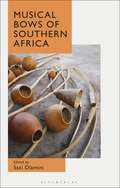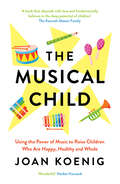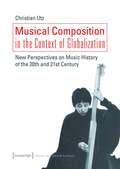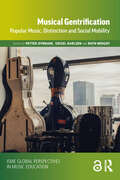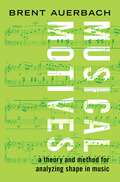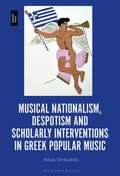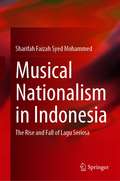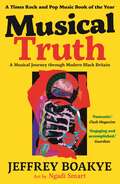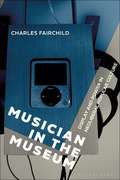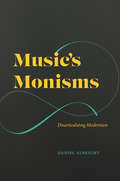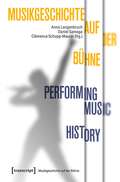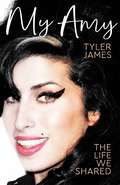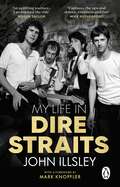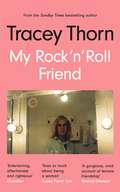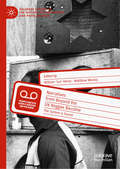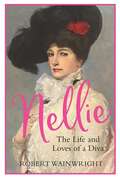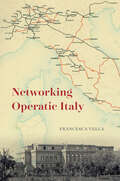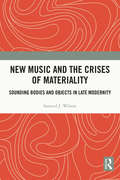- Table View
- List View
Musical Bows of Southern Africa
by Sazi DlaminiMusical Bows of Southern Africa brings together current scholarly research that documents a rich regional diversity as well as cultural relationships in bow music knowledge and contemporary practices. The book is framed as a critical appraisal of traditional ethnomusicological studies of the region – complementing pioneering studies and charting contexts for a contemporary engagement with bow music as an exchangeable cultural practice. Each contribution is written by an expert in the field and collectively demonstrates the multidisciplinary potential of bow music, highlighting the several fields of knowledge that intersect with bow music including ethno-organology, applied ethnomusicology, composition, music literacy, social development, cultural economics, history, orality, performance and language.
The Musical Child: Using The Power Of Music To Raise Children Who Are Happy, Healthy, And Whole
by Joan Koenig‘Wonderful … we need music in our lives now more than ever’ HERBIE HANCOCK‘Joan Koenig is on a wonderful mission to enrich children’s lives through music’ DR GUY DEUTSCHER A pioneering music educator reveals how music can supercharge early childhood development –and how parents and caregivers can harness it’s power.
Musical Composition in the Context of Globalization: New Perspectives on Music History in the 20th and 21st Century (Musik und Klangkultur #43)
by Christian UtzSince the early transformation of European music practice and theory in the cultural centers of Asia, Latin America, and Africa around 1900, it has become necessary for music history to be conceived globally - a challenge that musicology has hardly faced yet. This book discusses the effects of cultural globalization on processes of composition and distribution of art music in the 20th and 21st century. Christian Utz provides the foundations of a global music historiography, building on new models such as transnationalism, entangled histories, and reflexive globalization. The relationship between music and broader changes in society forms the central focus and is treated as a pivotal music-historical dynamic.
Musical Gentrification: Popular Music, Distinction and Social Mobility (ISME Series in Music Education)
by Petter Dyndahl Sidsel Karlsen Ruth WrightMusical Gentrification is an exploration of the role of popular music in processes of socio-cultural inclusion and exclusion in a variety of contexts. Twelve chapters by international scholars reveal how cultural objects of relatively lower status, in this case popular musics, are made objects of acquisition by subjects or institutions of higher social status, thereby playing an important role in social elevation, mobility and distinction. The phenomenon of musical gentrification is approached from a variety of angles: theoretically, methodologically and with reference to a number of key issues in popular music, from class, gender and ethnicity to cultural consumption, activism, hegemony and musical agency. Drawing on a wide range of case studies, empirical examples and ethnographic data, this is a valuable study for scholars and researchers of Music Education, Ethnomusicology, Cultural Studies and Cultural Sociology. The Open Access version of this book, available at http://www.taylorfrancis.com, has been made available under a Creative Commons Attribution-Non Commercial-No Derivatives (CC-BY-NC-ND) 4.0 license.
Musical Gentrification: Popular Music, Distinction and Social Mobility (ISME Series in Music Education)
by Petter Dyndahl Sidsel Karlsen Ruth WrightMusical Gentrification is an exploration of the role of popular music in processes of socio-cultural inclusion and exclusion in a variety of contexts. Twelve chapters by international scholars reveal how cultural objects of relatively lower status, in this case popular musics, are made objects of acquisition by subjects or institutions of higher social status, thereby playing an important role in social elevation, mobility and distinction. The phenomenon of musical gentrification is approached from a variety of angles: theoretically, methodologically and with reference to a number of key issues in popular music, from class, gender and ethnicity to cultural consumption, activism, hegemony and musical agency. Drawing on a wide range of case studies, empirical examples and ethnographic data, this is a valuable study for scholars and researchers of Music Education, Ethnomusicology, Cultural Studies and Cultural Sociology. The Open Access version of this book, available at http://www.taylorfrancis.com, has been made available under a Creative Commons Attribution-Non Commercial-No Derivatives (CC-BY-NC-ND) 4.0 license.
Musical Motives: A Theory and Method for Analyzing Shape in Music
by Brent AuerbachAll music fans harbor in their memories vivid fragments of their favorite works. The starting guitar solo of "Satisfaction" by the Rolling Stones, the da-da-da-DUM gesture that opens Beethoven's Fifth Symphony, the lush swelling chords of a beloved movie soundtrack: hearing the briefest snippet of any of these is enough to transport listeners into the piece's sonic and emotional world. But what makes musical motives so powerful? In Musical Motives, author Brent Auerbach looks at the ways that motives the small-scale pitch and rhythm shapes that are ever-present in music unify musical compositions and shape our experiences of them. Motives serve both to communicate basic musical meaning and to tie together sound space like the motifs in visual art. They present in all genres from classical and popular to jazz and world music, making them ideally suited for analysis. Musical Motives opens with a general introduction to these fundamental building blocks, then lays out a comprehensive theory and method to account for music's structure and drama in motivic terms. Aimed at both amateur and expert audiences, the book offers a tiered approach that progresses from Basic to Complex Motivic Analysis. The methods are illustrated by small- and large-scale analyses of pieces by Mozart, Beethoven, Handel, Chaminade, Verdi, Radiohead, and many more.
Musical Nationalism, Despotism and Scholarly Interventions in Greek Popular Music
by Nikos OrdoulidisThis book discusses the relationship between Greek Orthodox ecclesiastical music and laiko (popular) song in Greece. Laiko music was long considered a lesser form of music in Greece, with rural folk music considered serious enough to carry the weight of the ideologies founded within the establishment of the contemporary Greek state. During the 1940s and 1950s, a selective exoneration of urban popular music took place, one of its most popular cases being the originating relationships between two extremely popular musical pieces: Vasilis Tsitsanis's “Synnefiasmeni Kyriaki” (Cloudy Sunday) and its descent from the hymn “Ti Ypermacho” (The Akathist Hymn). During this period the connection of these two pieces was forged in the Modern Greek conscience, led by certain key figures in the authority system of the scholarly world. Through analysis of these pieces and the surrounding contexts, Ordoulidis explores the changing role and perception of popular music in Greece.
Musical Nationalism in Indonesia: The Rise and Fall of Lagu Seriosa
by Sharifah Faizah MohammedThis book charts the growth of the Indonesian nationalistic musical genre of lagu seriosa in relation to the archipelago's history in the 1950s and 1960s, examining how folk songs were implemented as a valuable tool for promoting government propaganda. The author reveals how the genre was shaped to fit state ideologies and agendas in the Sukarno and Soeharto eras. It also reveals the very significant role played by Radio Republik Indonesia in the genre’s development and dissemination. Little research has been done to investigate how Indonesian music contributed to nation-building during Indonesia’s immediate post-colonial period. Emulating the European art song, the genre was adapted to compose songs with the purpose of promoting a strengthened collective Indonesian identity, fostered by a group of musicians who functioned as gatekeepers, monitoring and devising various mechanisms for songs to conform to the propagandistic needs of the Indonesian government at the time. The result was the development of classical style of singing and the cultivation of a patriotic collection of music during the Guided Democracy period (1959–1965), which peaked at the height of the Konfrontasi (1963–1966). Lagu seriosa lost popularity as popular music infiltrated Indonesia in the 1970s, but it remains an iconic yet understudied aspect of the nationalistic agenda in Indonesia. The case studies of selected songs reflected continuity and change in musical style and over time. This book is of interest to scholars studying the intersection between history, politics, identity, arts and cultural studies in Indonesia. It is also of interest to researchers investigating the role of music in identity formation and nation-building more widely.
Musical Truth: A Musical History of Modern Black Britain in 28 Songs
by Jeffrey BoakyeMusic can carry the stories of history like a message in a bottle.Lord Kitchener, Neneh Cherry, Smiley Culture, Stormzy . . . Groundbreaking musicians whose songs have changed the world. But how? This exhilarating playlist tracks some of the key shifts in modern British history, and explores the emotional impact of 28 songs and the artists who performed them.This book redefines British history, the Empire and postcolonialism, and will invite you to think again about the narratives and key moments in history that you have been taught up to now.Thrilling, urgent, entertaining and thought-provoking, this beautifully illustrated companion to modern black music is a revelation and a delight.
Musician in the Museum: Display and Power in Neoliberal Popular Culture
by Charles FairchildIn recent years, popular music museums have been established in high profile locations in many of the presumed “musical capitals” of the world, such as Los Angeles, Liverpool, Seattle, Memphis, and Nashville. Most of these are defined by expansive experiential infrastructures centered around spectacular, high-tech displays of varying sizes and types. Through over-the-top acts of display, these museums influence and reflect the values and priorities in the public life of popular music. This book examines the phenomenon of the popular music museum outside the typical and familiar frames of heritage and tourism. Instead, it looks at these institutions as markers of the broader entertainment industry in the era of its rise to global dominance. It highlights the multiple manifestations of power as read across a range of institutions and material forms and discusses how this contributes to shaping the experience of popular culture.
Music's Monisms: Disarticulating Modernism
by Daniel AlbrightDaniel Albright investigates musical phenomena through the lens of monism, the philosophical belief that things that appear to be two are actually one. Daniel Albright was one of the preeminent scholars of musical and literary modernism, leaving behind a rich body of work before his untimely passing. In Music’s Monisms, he shows how musical and literary phenomena alike can be fruitfully investigated through the lens of monism, a philosophical conviction that does away with the binary structures we use to make sense of reality. Albright shows that despite music’s many binaries—diatonic vs. chromatic, major vs. minor, tonal vs. atonal—there is always a larger system at work that aims to reconcile tension and resolve conflict. Albright identifies a “radical monism” in the work of modernist poets such as T. S. Eliot and musical works by Wagner, Debussy, Britten, Schoenberg, and Stravinsky. Radical monism insists on the interchangeability, even the sameness, of the basic dichotomies that govern our thinking and modes of organizing the universe. Through a series of close readings of musical and literary works, Albright advances powerful philosophical arguments that not only shed light on these specific figures but also on aesthetic experience in general. Music’s Monisms is a revelatory work by one of modernist studies’ most distinguished figures.
Musik als Spiel - Spiel als Musik: Die Integration von Spielkonzepten in zeitgenössischer Musik, Musiktheater und Klangkunst (Musik und Klangkultur #40)
by Sebastian RoseAußermusikalische Prinzipien des Spiels - freie wie streng regelbasierte - können Kompositionsprozesse, Aufführungssituationen oder Rezeptionsvorgänge prägen und bestehende Denkmuster aufbrechen. Daher hat der Spielbegriff als ästhetische Kategorie in den Künsten des 20. Jahrhunderts deutlich an Relevanz gewonnen und bis heute entstehen vielfältige kompositorische Konzepte, die Formen, Interaktionen und Oberflächen von analogen wie digitalen Spielen adaptieren. Die Beiträger*innen aus den Bereichen Komposition, Musik- und Kulturwissenschaft und Spieleentwicklung untersuchen markante Beispiele, in denen auf je eigene Weise Musik und Spiel als zwei eigenständig gewachsene Kulturformen zusammengeführt werden.
Musik und Fuzzy Logic: Die Dialektik von Idee und Realisierungen im Werkprozess
by Hanns-Werner HeisterDas Buch entfaltet die vielfältigen Wechselbeziehungen zwischen Fuzzy Logic und Musik in einem ersten umfassenden Überblick. Es behandelt systematisch sowohl die in diesem Zusammenhang relevanten Aspekte der Fuzzy Logic als auch die der Musik. Im Werkprozess mit drei Hauptphasen und dreizehn Existenzformen des Kunstwerks, in den Musikarten Klassik, Jazz, Pop, Folklore, zeigen sich die vier Hauptprinzipien (mit fünf Phänotypen) der Fuzzy Logic in Bezug auf die Musik: Ähnlichkeit, Schärfung I als Filterung und Schärfung II als Kristallisation, Verwischung, Variation. Ein neues Konzept ist die Dialektik zwischen Schärfung und – bewusster – "Unschärfe" durch die Verwischung. Abschließend werden Aspekte der mehrdimensionalen Dialektik in historischer Dimension entwickelt, samt einem ‚Musical Turn‘ in den Wissenschaften und Überlegungen zu einer 'Philosophie der FL'. Das produktionsorientierte Denken der Fuzzy Logic und die Musik-Analyse befruchten sich wechselseitig.
Musikgeschichte auf der Bühne - Performing Music History (Musikgeschichte auf der Bühne #2)
by Anna Langenbruch Daniel Samaga Clémence Schupp-MaurerOb als Oper, Musical, dramatische Montage oder historisches Pastiche: Performative Zugänge zur Musikgeschichtsschreibung bringen Geschichte auf die Bühne. Dazu stellen sie Verbindungen zwischen Vergangenheit und Gegenwart her und arbeiten mit Klängen, historischem Material oder etablierten Bildern von Künstler*innen. Die Beiträger*innen des Bandes fragen danach, wie Musikgeschichte auf der Bühne erzählt, komponiert, inszeniert und verkörpert wird: Was zeichnet diese intermediale Form der Musikhistoriographie aus? Wie verhält sie sich zur Geschichtsschreibung in anderen Medien? Und welche narrativen Strategien und Praktiken, welche Geschichtsbilder prägen Musikgeschichten auf der Bühne?
My Amy: The Life We Shared
by Tyler JamesWritten with a searing honesty and published for the tenth anniversary of Amy Winehouse's death, My Amy is an evocative portrait of unbreakable lifelong friendship – and a devastating study into fame, addiction and self-sabotage.Only one person knows what really happened to Amy, other than Amy herself. He is Tyler James, Amy’s best friend from the age of thirteen. They met at stage school as two insecure outsiders, formed an instant connection and lived together from their late teenage years right up until the day she died, aged just twenty-seven.Tyler was there by her side through it all. From their carefree early years touring together to the creation of the multiple Grammy-winning Back To Black, which she wrote on their kitchen floor. From her volatile marriage to Blake Fielder-Civil through her escalating addictions, self-harm and eating disorders as the toxic nature of fame warped Amy’s reality. For the last three years of her life, Tyler was with her every day when she’d beaten drugs and was close to beating alcoholism too. He also knew better than anyone the real Amy Winehouse who the tabloid-reading public rarely saw – the hilarious, uncompromising force-of-nature busy taking care of everyone else.We all think we know what happened to Amy Winehouse, but we don’t. This definitive insider’s story tells us all, finally, the truth.
My Life in Dire Straits: The Inside Story of One of the Biggest Bands in Rock History
by John IllsleyWith a foreword by MARK KNOPFLER'An uplifting journey through the sheer hard work, pitfalls and thrills of navigating a great rock band to the pinnacle of success. I so enjoyed the ride!' ROGER TAYLOR, Queen__________Dire Straits filled giant stadiums around the world and sold hundreds of millions of records. Throughout the eighties they were one of the biggest bands on the planet. Their classic songs - 'Sultans of Swing', 'Romeo and Juliet', 'Money for Nothing', 'Brothers In Arms' - formed the soundtrack of a generation and live on today: still racking up sales, still being played on the radio on every continent. In My Life in Dire Straits, John Illsley - founding member, bassist and mainstay - evokes the spirit of the times and tells the story of one of the great live acts of rock history.Starting with his own unlikely beginnings in Middle England, he recounts the band's rise from humble origins in London's spit-and-sawdust pubs to the best-known venues in the world, the working man's clubs to Madison Square Garden, gigging with wild punk bands to the Live Aid stage at Wembley. Until, ultimately, the shattering demands of touring on a global scale and living life in the spotlight took their inevitable toll.John's story is also a tribute to his great friend Mark Knopfler, the band's lead singer, songwriter and gifted guitarist - the only band members to stay the fifteen-year distance. Told with searching honesty, soulful reflection and wry humour, this is the first and only account of that incredible story.
My Rock 'n' Roll Friend
by Tracey Thorn'Entertaining, affectionate and righteous' Guardian 'Says so much about being a woman' Cosey Fanni Tutti In 1983, backstage at the Lyceum in London, Tracey Thorn and Lindy Morrison first met. Tracey’s music career was just beginning, while Lindy, drummer for The Go-Betweens, was ten years her senior. They became confidantes, comrades and best friends, a relationship cemented by gossip and feminism, books and gigs and rock ’n’ roll love affairs. Morrison – a headstrong heroine blazing her way through a male-dominated industry – came to be a kind of mentor to Thorn. They shared the joy and the struggle of being women in a band, trying to outwit and face down a chauvinist music media. In My Rock 'n' Roll Friend Thorn takes stock of thirty-seven years of friendship, teasing out the details of connection and affection between two women who seem to be either complete opposites or mirror images of each other. This important book asks what people see, who does the looking, and ultimately who writes women out of – and back into – history.
Naná Vasconcelos’s Saudades (33 1/3 Brazil)
by Daniel B. SharpThe story of Afro-Brazilian percussionist Naná Vasconcelos stitches together histories of 1960s-1980s jazz, psychedelia, world music, experimentalism and post-punk. Based in Recife, Rio de Janeiro, New York City and Paris, Naná played with musicians as varied as Egberto Gismonti, Don Cherry, Pat Metheny, Ralph Towner, Arto Lindsay, Talking Heads, Laurie Anderson, Paul Simon, Jon Hassell, Brian Eno, Os Mutantes, and Milton Nascimento.This book traces the 15 years (1964-1979) leading up to Naná's Saudades (1979, ECM), an album evoking his sonic memories of Brazil that he recorded while in Germany. Saudades features berimbau, a one-stringed instrument that looks like a bow and arrow, alongside onomatopoetic vocals and the strings of the Radio Symphony Stuttgart. Daniel B. Sharp hears Naná's playing as a counterargument against dishonest notions of the primitive just as world music emerged as a genre. With a gourd, a stick, a wire, a wicker basket, and a stone, Naná made music as complex and contemporary as the ARP synthesizers in vogue at the time.
Naná Vasconcelos’s Saudades (33 1/3 Brazil)
by Daniel B. SharpThe story of Afro-Brazilian percussionist Naná Vasconcelos stitches together histories of 1960s-1980s jazz, psychedelia, world music, experimentalism and post-punk. Based in Recife, Rio de Janeiro, New York City and Paris, Naná played with musicians as varied as Egberto Gismonti, Don Cherry, Pat Metheny, Ralph Towner, Arto Lindsay, Talking Heads, Laurie Anderson, Paul Simon, Jon Hassell, Brian Eno, Os Mutantes, and Milton Nascimento.This book traces the 15 years (1964-1979) leading up to Naná's Saudades (1979, ECM), an album evoking his sonic memories of Brazil that he recorded while in Germany. Saudades features berimbau, a one-stringed instrument that looks like a bow and arrow, alongside onomatopoetic vocals and the strings of the Radio Symphony Stuttgart. Daniel B. Sharp hears Naná's playing as a counterargument against dishonest notions of the primitive just as world music emerged as a genre. With a gourd, a stick, a wire, a wicker basket, and a stone, Naná made music as complex and contemporary as the ARP synthesizers in vogue at the time.
Narratives from Beyond the UK Reggae Bassline: The System is Sound (Palgrave Studies in the History of Subcultures and Popular Music)
by William ‘Lez’ Henry Matthew WorleyThis book explores the history of reggae in modern Britain from the time it emerged as a cultural force in the 1970s. As basslines from Jamaica reverberated across the Atlantic, so they were received and transmitted by the UK’s Afro-Caribbean community. From roots to lovers’ rock, from deejays harnessing the dancehall crowd to dub poets reporting back from the socio-economic front line, British reggae soundtracked the inner-city experience of black youth. In time, reggae’s influence permeated the wider culture, informing the sounds and the language of popular music whilst also retaining a connection to the street-level sound systems, clubs and centres that provided space to create, protest and innovate. This book is therefore a testament to struggle and ingenuity, a collection of essays tracing reggae’s importance to both the culture and the politics of late twentieth and early twenty-first century Britain.
Nellie: The Life and Loves of a Diva
by Robert WainwrightNellie Melba is remembered as a squarish, late middle-aged woman dressed in furs and large hats, an imperious Dame whose voice ruled the world for three decades and inspired a peach and raspberry dessert. But to succeed, she had to battle social expectations and misogyny that would have preferred she stay a housewife in outback Queensland rather than parade herself on stage. She endured the violence of a bad marriage, was denied by scandal a true love with the would-be King of France, and suffered for more than a decade the loss of her only son - stolen by his angry, vengeful father. Despite these obstacles, she built and maintained a career as an opera singer and businesswoman on three continents which made her one of the first international superstars. Award-winning biographer Robert Wainwright presents a very different portrait of this great diva, one that celebrates both her musical contributions and her rich and colourful personal life.
Nenes' Koza Dabasa: Okinawa in the World Music Market (33 1/3 Japan)
by Henry JohnsonKoza Dabasa explores Okinawa's island culture and its ghosts of war through the lens of Nenes, a four-woman pop group that draws on the distinctiveness and exoticism of Okinawan musical tradition. Both a tropical island paradise and the site of some of the bloodiest battles of World War II, Okinawa has a unique culture and a contentious history. Its musical traditions are distinct from other parts of Japan, varying in instrumentation, poetic forms, and musical scales. Nenes marks its cultural difference as Okinawan by emphasizing its own exoticism, expressed through its music, fashion, imagery, and performance style. Henry Johnson listens to Koza Dabasa as a representation of Okinawa's relationship with the Japanese music industry and with the broader themes of international warfare and local tourism.33 1/3 Global, a series related to but independent from 33 1/3, takes the format of the original series of short, music-based books and brings the focus to music throughout the world. With initial volumes focusing on Japanese and Brazilian music, the series will also include volumes on the popular music of Australia/Oceania, Europe, Africa, the Middle East, and more.
Networking Operatic Italy (Opera Lab: Explorations in History, Technology, and Performance)
by Francesca VellaA study of the networks of opera production and critical discourse that shaped Italian cultural identity during and after Unification. Opera’s role in shaping Italian identity has long fascinated both critics and scholars. Whereas the romance of the Risorgimento once spurred analyses of how individual works and styles grew out of and fostered specifically “Italian” sensibilities and modes of address, more recently scholars have discovered the ways in which opera has animated Italians’ social and cultural life in myriad different local contexts. In Networking Operatic Italy, Francesca Vella reexamines this much-debated topic by exploring how, where, and why opera traveled on the mid-nineteenth-century peninsula, and what this mobility meant for opera, Italian cities, and Italy alike. Focusing on the 1850s to the 1870s, Vella attends to opera’s encounters with new technologies of transportation and communication, as well as its continued dissemination through newspapers, wind bands, and singing human bodies. Ultimately, this book sheds light on the vibrancy and complexity of nineteenth-century Italian operatic cultures, challenging many of our assumptions about an often exoticized country.
Networking Operatic Italy (Opera Lab: Explorations in History, Technology, and Performance)
by Francesca VellaA study of the networks of opera production and critical discourse that shaped Italian cultural identity during and after Unification. Opera’s role in shaping Italian identity has long fascinated both critics and scholars. Whereas the romance of the Risorgimento once spurred analyses of how individual works and styles grew out of and fostered specifically “Italian” sensibilities and modes of address, more recently scholars have discovered the ways in which opera has animated Italians’ social and cultural life in myriad different local contexts. In Networking Operatic Italy, Francesca Vella reexamines this much-debated topic by exploring how, where, and why opera traveled on the mid-nineteenth-century peninsula, and what this mobility meant for opera, Italian cities, and Italy alike. Focusing on the 1850s to the 1870s, Vella attends to opera’s encounters with new technologies of transportation and communication, as well as its continued dissemination through newspapers, wind bands, and singing human bodies. Ultimately, this book sheds light on the vibrancy and complexity of nineteenth-century Italian operatic cultures, challenging many of our assumptions about an often exoticized country.
New Music and the Crises of Materiality: Sounding Bodies and Objects in Late Modernity
by Samuel WilsonThis book explores the transformation of ideas of the material in late twentieth- and early twenty-first-century musical composition. New music of this era is argued to reflect a historical moment when the idea of materiality itself is in flux. Engaging with thinkers such as Theodor Adorno, Sara Ahmed, Zygmunt Bauman, Rosi Braidotti, and Timothy Morton, the author considers music's relationship with changing material conditions, from the rise of neo-liberalisms and information technologies to new concepts of the natural world. Drawing on musicology, cultural theory, and philosophy, the author develops a critical understanding of musical bodies, objects, and the environments of their interaction. Music is grasped as something that both registers material changes in society whilst also enabling us to practice materiality differently. book focuses on how recent music and sound art have expressed notions of the body and the material environment. It engages with thinkers such as to demonstrate how this music relates to changing material conditions, from the
